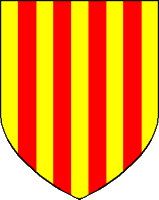
Counts of Roussillon
Encyclopedia

Count
A count or countess is an aristocratic nobleman in European countries. The word count came into English from the French comte, itself from Latin comes—in its accusative comitem—meaning "companion", and later "companion of the emperor, delegate of the emperor". The adjective form of the word is...
of Roussillon
County of Roussillon
The County of Roussillon was one of the Catalan counties in the Marca Hispanica during the Middle Ages. The rulers of the county were the Counts of Roussillon, whose interests lay both north and south of the Pyrenees.-Visigothic county:...
, in Catalan
Catalan language
Catalan is a Romance language, the national and only official language of Andorra and a co-official language in the Spanish autonomous communities of Catalonia, the Balearic Islands and Valencian Community, where it is known as Valencian , as well as in the city of Alghero, on the Italian island...
Rosselló.
Carolingian counts
These counts were nominated by the CarolingianCarolingian
The Carolingian dynasty was a Frankish noble family with origins in the Arnulfing and Pippinid clans of the 7th century AD. The name "Carolingian", Medieval Latin karolingi, an altered form of an unattested Old High German *karling, kerling The Carolingian dynasty (known variously as the...
kings of France, of whom they were vassals.
- GaucelmGaucelmGaucelm was a Frankish count and leading magnate in Gothia during the reign of Louis the Pious. He was initially the Count of Roussillon from about 800, but he received Empúries in 817 and was thenceforward the chief representative of imperial authority in that region.He was the son of William of...
(812–832)
Hereafter, also counts of Barcelona.
- Berenguer of Toulouse (832–835)
- Bernat of SeptimaniaBernat of SeptimaniaBernard of Septimania , son of William of Gellone, was the Frankish Duke of Septimania and Count of Barcelona from 826 to 832 and again from 835 to his execution. He was also count of Carcassonne from 837. He was appointed to succeed his fellow Frank Rampon...
(835–844) - Sunifred I, also known as Sunyer, (844–848)
- Guillem (848–850)
- Aleran (850–852)
- IsembartIsembartIsembart or Isembard was the count of Barcelona, Empúries, and Roussillon and margrave of Septimania together with Aleran from 849 or 850 to 852.He was the son of Garí of Burgundy, count of Autun.He was named at the assembly of Narbonne in 849...
(850–852) - OdalricOdalric, Count of BarcelonaOdalric, Odalrico, Odalrih, Odelric, or Udalrich was the Count of Barcelona, Count of Girona, Count of Rosselló, Count of Empúries and Margrave of Septimania from 852 to 858....
(852–858) - Humfrid (858–864)
- Bernat of GothiaBernat of Gothia, Count of BarcelonaBernard II was the Count of Barcelona, Girona and Margrave of Gothia and Septimania from 865 to 878.-Origins:...
(865–878)
No longer counts of Barcelona.
- Miro the ElderMiro the ElderMiro, called the Old or the Elder was the count of Conflent from 870 and Rosselló from 878 until his death...
(878–895)
Independent counts
These counts were also count of Empúries. By this time the counts were practically independent.- Sunifred II (895–915)
- BencionBencionBencion was the count of Empúries and Rosselló from 915 to his death. He was the son of Sunyer II of Empúries, whom he succeeded.He married Godlana, daughter of Miro the Elder of Conflent and Roussillon....
(915–916) - GausbertGausbertGausbert was the count of Empúries and Rosselló from 915 until he died. He was the son of Sunyer II of Empúries and brother of Bencion....
(915–931) - Gausfred IGausfred IGausfred I was the count of Empúries and Rosselló from 931 until his death. He was the son and successor of Gausbert. He spent his whole life consolidating his authority in his counties, but he divided the realm amongst his sons...
, also known as Wilfred, (931–991)
The counts thereafter were no longer counts of Empúries.
- Giselbert I, also known as Guislabert, (991–1014)
- Gausfred II (1014–1074)
- Giselbert II (1074–1102)
- Girard I, also known as Guinard, (1102–1113)
- Gausfred III (1113–1164)
- Girard II (1164–1172), died without heirs
The county subsumed with the Crown of Aragón
Crown of Aragon
The Crown of Aragon Corona d'Aragón Corona d'Aragó Corona Aragonum controlling a large portion of the present-day eastern Spain and southeastern France, as well as some of the major islands and mainland possessions stretching across the Mediterranean as far as Greece...
. Later, briefly...
- Sancho (1209–1223), also count of CerdanyaCerdanyaCerdanya is a natural comarca and historical region of the eastern Pyrenees divided between France and Spain. Historically it has been one of the counties of Catalonia....
- Nuño Sancho (1223–1242), also count of CerdanyaCerdanyaCerdanya is a natural comarca and historical region of the eastern Pyrenees divided between France and Spain. Historically it has been one of the counties of Catalonia....
For subsequent counts of Roussillon (and Cerdagne), see Kingdom of Majorca
Kingdom of Majorca
The Kingdom of Majorca was founded by James I of Aragon, also known as James The Conqueror. After the death of his first-born son Alfonso, a will was written in 1262 which created the kingdom in order to cede it to his son James...
.
Fictional counts
- A fictional Count of Roussillon, Bertram, is a principal character in William ShakespeareWilliam ShakespeareWilliam Shakespeare was an English poet and playwright, widely regarded as the greatest writer in the English language and the world's pre-eminent dramatist. He is often called England's national poet and the "Bard of Avon"...
's play All's Well That Ends WellAll's Well That Ends WellAll's Well That Ends Well is a play by William Shakespeare. It is believed to have been written between 1604 and 1605, and was originally published in the First Folio in 1623....
.

